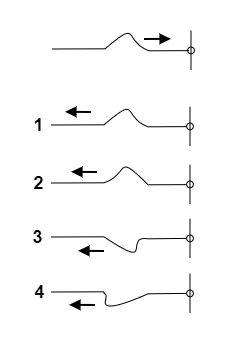Question
Question: A pulse moves in a string as indicated in the sketch. At the end of the string is a ring that can sl...
A pulse moves in a string as indicated in the sketch. At the end of the string is a ring that can slide without friction on a post. On reflection, the pulse would most nearly be represented by

Solution
Here the ring attached to the end of the string is allowed to move freely along the post. So the pulse gets reflected from a boundary which is not rigid but can completely move freely. This implies that no inversion of the incident pulse takes place upon reflection.
Complete answer:
Step 1: Describe the reflection of the pulse at the post.
The problem at hand involves a pulse in a string which gets reflected at a post along which a ring attached to the string freely moves. The incident pulse is sketched below.

As the ring attached to one end of the string is allowed to move freely along the post, this end of the string corresponds to a free end or a non-rigid boundary. Then the crest of the given pulse on reaching the end of the string will cause the ring to slide upwards along the post. This causes the pulse to get reflected without inversion. The reflected wave will thus have the same phase and the same amplitude as that of the incident pulse. This is shown in figure 2.

So the correct option is B.
Additional information:
An incident pulse with upward displacement after reflection from an open boundary will return with an upward displacement and an incident pulse with upward displacement after reflection from a rigid boundary will return with a downward displacement.
Note:
Here is mentioned that no friction exists between the ring and the post. It is only because of this that the end of the ring attached to the post is treated as a free end. A wave reflected from a free end will suffer no change in the phase and no energy is lost on reflection as the amplitude remains the same.
